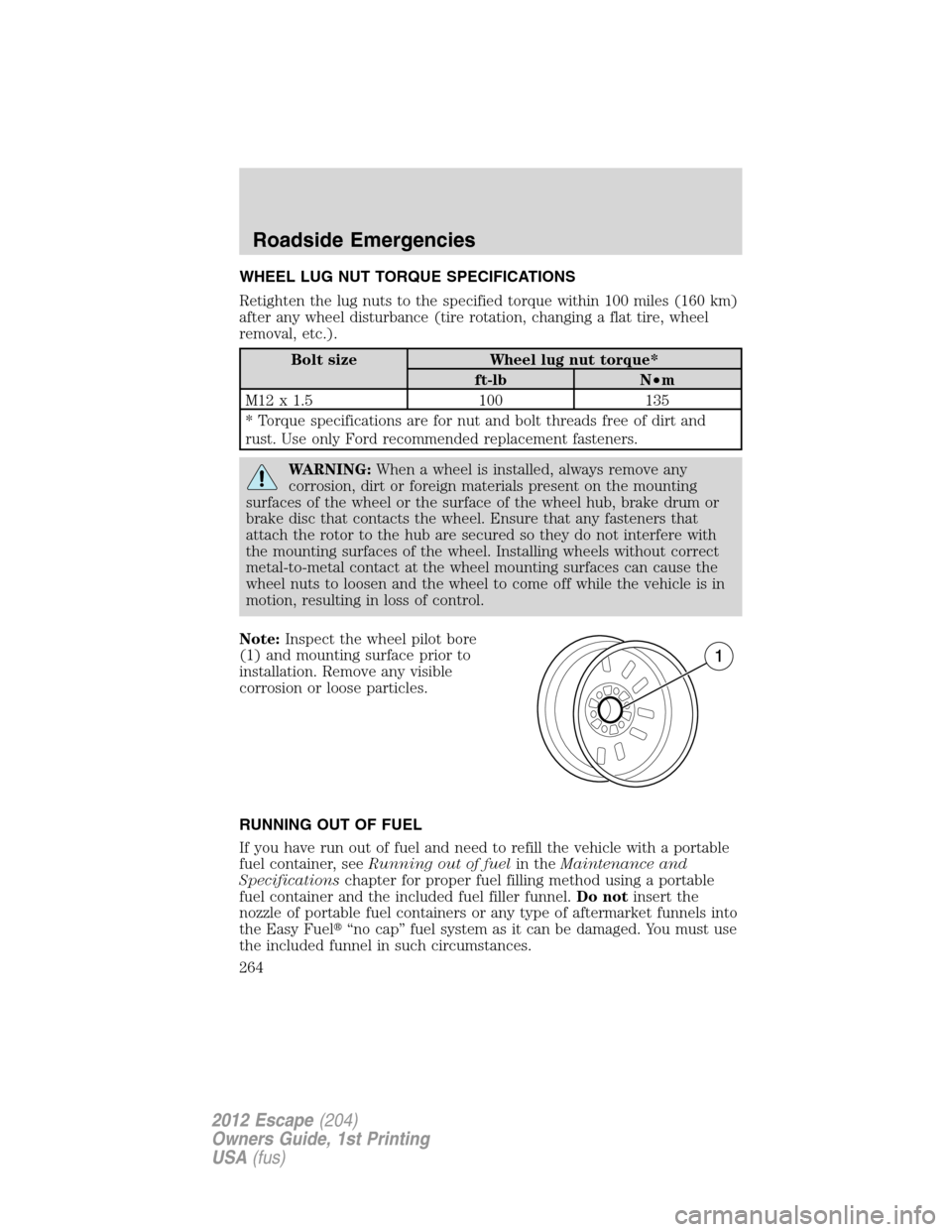Page 2 of 361
Locks and Security 92
Keys 92
Locks 98
Anti-theft system 108
Seating and Safety Restraints 112
Seating 112
Personal Safety System™ 124
Safety belt system 128
Airbags 138
Child restraints 154
Tires, Wheels and Loading 172
Tire information 174
Tire inflation 177
Tire Pressure Monitoring System (TPMS) 189
Vehicle loading 194
Trailer towing 201
Recreational towing 204
Driving 206
Starting 206
Brakes 212
AdvanceTrac�215
Transmission operation 224
Reverse sensing system 228
Rear-view camera system 230
Roadside Emergencies 245
Getting roadside assistance 245
Hazard flasher control 246
Fuel pump shut-off switch 247
Fuses and relays 247
Changing tires 254
Wheel lug nut torque 264
Jump starting 265
Wrecker towing 268
Table of Contents
2
2012 Escape(204)
Owners Guide, 1st Printing
USA(fus)
Page 224 of 361

AUTOMATIC TRANSMISSION OPERATION (IF EQUIPPED)
Automatic transmission adaptive learning
Your transmission is equipped with an adaptive learning strategy found in
the vehicle computer. This feature is designed to increase durability and
provide consistent shift feel over the life of the vehicle. A new vehicle or
transmission may have firm and/or soft shifts. This operation is
considered normal and will not affect function or durability of the
transmission. Over time, the adaptive learning process will fully update
transmission operation. Additionally, whenever the battery is
disconnected or a new battery installed, the strategy must be relearned.
Understanding the gearshift positions of the 6–speed automatic
transmission
Your vehicle has been designed to improve fuel economy by reducing
fuel usage while coasting or decelerating. When you take your foot off
the accelerator pedal and the vehicle begins to slow down, the torque
converter clutch locks up and aggressively shuts off fuel flow to the
engine while decelerating. This fuel economy benefit may be perceived
as a light to medium braking sensation when removing your foot from
the accelerator pedal.
P (Park)
This position locks the transmission
and prevents the front wheels from
turning.
To put your vehicle in gear:
1. Press the brake pedal.
2. Move the gearshift lever into the
desired gear.
To put your vehicle in P (Park):
1. Come to a complete stop.
2. Move the gearshift lever and
securely latch it in P (Park).
WARNING:Always set the parking brake fully and make sure
the gearshift is latched in P (Park). Turn the ignition to the off
position and remove the key whenever you leave your vehicle.
Driving
224
2012 Escape(204)
Owners Guide, 1st Printing
USA(fus)
Page 262 of 361

Never use the differentials as a
jacking point.
WARNING:To lessen the
risk of personal injury, do not
put any part of your body under
the vehicle while changing a tire.
Do not start the engine when your
vehicle is on the jack. The jack is
only meant for changing the tire.
4. Remove the lug nuts with the lug nut wrench.
5. Replace the flat tire with the spare tire, making sure the valve stem is
facing outward. Reinstall lug nuts until the wheel is snug against the hub.
Do not fully tighten the lug nuts until the wheel has been lowered.
6. Lower the wheel by turning the jack handle counterclockwise.
7. Remove the jack and fully tighten
the lug nuts in the order shown.
Refer toWheel lug nut torque
specificationslater in this chapter
for the proper lug nut torque
specification.
Stowing the jack and tools
•Make sure the jack is fully
lowered.
•Reclip the tools onto the jack
making sure that the tools are
fully contained by the clips as
shown.
•Reinstall the jack in the pocket
with the left side first, then snap
the right side down.
•Ensure that the hold-strap contains the jack and tools before snapping
the buckle.
•Ensure that the jack and tools are oriented as illustrated.
1
4 3
2 5
Roadside Emergencies
262
2012 Escape(204)
Owners Guide, 1st Printing
USA(fus)
Page 264 of 361

WHEEL LUG NUT TORQUE SPECIFICATIONS
Retighten the lug nuts to the specified torque within 100 miles (160 km)
after any wheel disturbance (tire rotation, changing a flat tire, wheel
removal, etc.).
Bolt size Wheel lug nut torque*
ft-lb N•m
M12 x 1.5 100 135
* Torque specifications are for nut and bolt threads free of dirt and
rust. Use only Ford recommended replacement fasteners.
WARNING:When a wheel is installed, always remove any
corrosion, dirt or foreign materials present on the mounting
surfaces of the wheel or the surface of the wheel hub, brake drum or
brake disc that contacts the wheel. Ensure that any fasteners that
attach the rotor to the hub are secured so they do not interfere with
the mounting surfaces of the wheel. Installing wheels without correct
metal-to-metal contact at the wheel mounting surfaces can cause the
wheel nuts to loosen and the wheel to come off while the vehicle is in
motion, resulting in loss of control.
Note:Inspect the wheel pilot bore
(1) and mounting surface prior to
installation. Remove any visible
corrosion or loose particles.
RUNNING OUT OF FUEL
If you have run out of fuel and need to refill the vehicle with a portable
fuel container, seeRunning out of fuelin theMaintenance and
Specificationschapter for proper fuel filling method using a portable
fuel container and the included fuel filler funnel.Do notinsert the
nozzle of portable fuel containers or any type of aftermarket funnels into
the Easy Fuel�“no cap” fuel system as it can be damaged. You must use
the included funnel in such circumstances.
Roadside Emergencies
264
2012 Escape(204)
Owners Guide, 1st Printing
USA(fus)